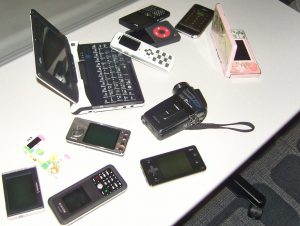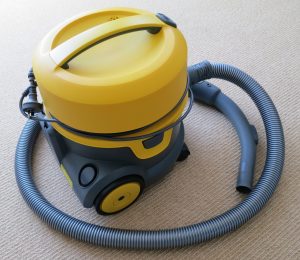| Average Australian home | $6000 a year / 5.7kWh a day / 1.4 ton C02 per year |
|---|---|
| Smart renter | $3000 a year / 3kWh a day / 0.7 ton C02 per year |
| Very smart renter | $1500 a year / 1kWh a day / 0.2 ton C02 per year |
*Costs for all categories include the cost of energy for appliances and gadgets, the cost of purchasing these items and repurchasing them when they inevitably wear out and the cost of having a broadband and mobile data connection to use some of these devices.
Appliances are the second biggest energy user in the average Australian household costing around $400 a year to run. But as you can see from the figures above, the energy used to run appliances and gadgets is just a fraction of the total costs of ownership.
As of 2015, it was estimated that the Internet of Things devices (so called smart devices) were costing the average Australian adult $2300 a year and $3000 if you had at least one child at home [1].
Given that the average Australian home statistically has 2.6 people, it would be safe to say that the average household would spend $5000 on such devices including the internet connection.
Add $400 in electricity for the electricity used by other appliances, $600 a year to replace appliances as they wear out and it’s safe to say that $6000 a year for the average Australian home is not an unreasonable estimate, in fact this is probably conservative for some households.
This doesn’t include the cost of owning and running a fridge and freezer which is covered separately in Smart food storage or appliance standby power.
The strategy for smart renters is twofold: Get rid of the appliances that add no real value to your life and make the best use of the ones you want to keep. Bear with us here, there’s a bit to cover but given the potential savings it’s worth the effort.
There are too many appliances to cover here so we’ll only cover the main ones:
Computers
PCs use the most energy but are the easiest to repair. If you have one, it probably makes sense to wear it out first before getting a replacement, even if you are a heavy user unless you are planning to go off grid or have frequent blackouts.
Now that we don’t have a PC, we prefer having a laptop as it uses very little energy (especially the ones with 15 inch screens or smaller) and it doubles as our TV.
A laptop can be easily set up anywhere and if you watch free to air TV, you can even buy a device to watch TV on your laptop. Unless you place heavy demands on your computers, you can buy laptops with plenty of computing power that cost around $500-$700.
As a two person household we only need one: it’s one less thing to worry about and we can negotiate around sharing a laptop plus even a basic smartphone will enable you to browse online or watch videos if the household laptop is in use, plus we find that one laptop discourages us for spending too much time online.
Gadgets
As for other so called “smart devices” outside of phones, we don’t really see the point. A family member gave us a tablet and after two years we gave it back because it wasn’t being used; a tablet couldn’t replace our laptop for word processing or music recording while a mobile phone is fine for light browsing.
It seems that none of these devices have gotten rid of the need for the previous device with the exception of laptops superseding PCs.
Tablets haven’t fully replaced laptops, “smart” watches haven’t replaced “smart” phones and E-book readers haven’t replaced books, plus buying E-books is almost as expensive as buying paper books, yet the books can’t be shared easily or resold.
If we are travelling light, a couple of paperbacks and a free E-book borrowing service on a smart phone is enough.

“Smart Gadget Story and UC” by RonanPark is licensed under CC BY 2.0
Phones
Thanks to the constant evolution of smart phone design, an entry level smart phone can do what most people need (texting, calls, web browsing, watching videos, etc.).
One of us bought a $150 smart phone with a 5 inch screen that works well; it is now two years old and still working fine despite being dropped dozens of times. Even the camera is decent.
With cheaper phones, there’s an added bonus: you can access the battery which means that you can replace it when the original wears out which will prolong the life of the phone.
Cheap replacement batteries can be found on EBay for almost every imaginable phone. The other way to prolong the life of a smart phone is not to let the battery run super flat on a regular basis; battery lifespans are based on a certain number of cycles from 100% to 0% and the lifespan can be extended by say recharging your phone at 50% or 70%.
Connectivity
A big cost of computers, “smart” devices and phones is that cost of connecting to the internet to use them. Once you make these devices work for you, this cuts your connectivity costs dramatically.
A household can manage on a $50 a month broadband plan and an $8-$15 a month phone plan for each adult in the house which has unlimited calls, texting and 1-2GB of data for navigation and a bit of web browsing whilst on the move.
Entertainment appliances
As mentioned above, we like using a laptop as a TV because even though it is smaller, it can be placed close to us on the coffee table and it doesn’t dominate our living area; we have set our living area up for conversation and reading, not for hours of watching TV.
The above may be a bit radical for some, so here’s an alternative:
Multiple TVs aren’t necessary so you could save money and have one TV in the living area. This would discourage excessive TV watching especially for families and with the availability of home recording devices, it’s easy to catch up on programs later if two or more people want to watch a different program at the same time.
Each large TV and corresponding entertainment system that’s on for 5 hours a day will cost around $150 a year to run while a small TV with minimal additional devices will cost around $30 a year.
So you can save a fair bit by getting a smaller TV in both the purchase cost and electricity use. Besides, most large TVs need to be set 5-6 metres away from the viewer/s so why not get a smaller one and bring it closer?
Also, if you’re looking for a bit of background entertainment while cooking or cleaning, a radio or stereo uses a lot less power.
Washing machine/dryer and vacuum cleaner

Detergents are designed to work in cold water so you can save a lot of energy by washing in cold water.
Airing clothes (except underwear and socks) can help to freshen them without a wash whilst unless you’re doing something really messy, you’ll find that most clothes don’t need to be washed everyday which cuts down on the amount of washing (and work) that you need to do each week.
This will also prolong the life of your washing machine. We found a 5.5kg top loader washing machine for $400 that has an low water rinse option that only uses 70 litres for a full load, similar to a front loader but cheaper to buy.
The best dryer is a washing line and clothes rack. They both cost little and don’t break down. In Melbourne and in Germany, we have never owned a dryer (which really pays off come moving time). For occasional items like drying a doona in the middle of winter, we go to the laundromat.
As for vacuum cleaners, if you have no carpet, then a dustpan and broom is fine. If you do have carpet, there are lightweight commercial vacuum cleaners that are much sturdier and yet cost just $300. Ours doesn’t have a retractable power cable which is something that usually breaks down over time and it looks easy to repair if something like the on/off switch fails.
Kitchen gadgets
Blenders, milkshake makers, doughnut makers, bread makers, dehydrators, the list goes on. Everyone’s situation is different and sometimes a certain device can be really useful in the kitchen. We try to minimise these as they often don’t last and usually there’s a simpler way to do the same job. A toaster and kettle are enough for us.
If you do use a certain device a lot, be prepared to spend on a good quality product (Be careful here, expensive and good quality are not always the same thing); better to buy a good quality once than to go through ten poorly built ones in the same lifespan of a good product.
Power Tools

Power tools generally don’t make up much of a household power bill unless you use them regularly. As with the kitchen, buy only what is useful and buy tool quality to match the job.
For example, we are happy with mid-level power tools as we want tools that will last but we are not heavy users. And we don’t have a garage full of them; an air or electric nail gun is useful if you are framing houses for a living, but a hammer is just fine for the work we do and is actually better for intricate work and delicate timber.
Avoid cordless tools unless you are going off grid and don’t want to run an inverter; Corded tools are cheaper to buy and last for a long time because there is no battery that will wear out and may be irreplaceable if the tool is discontinued.
Also, consider second hand tools; sometimes, you can by a high quality second hand power tool for the same price or even a lower price than a cheap unit that won’t last.
Summary
So here’s the benchmark for a very smart renter: Outside of refrigeration, a household could spend:
- $600 on a laptop ($120 a year),
- Buy two entry level smart phones for $300 ($100 a year)
- Buy a small stereo for $300 ($30 a year)
- Get a washing machine with a low water rinse option for $400 ($40 a year)
- Use a washing line
- Get an entry level commercial vacuum cleaner for $300 ($30 a year if necessary)
- Have a minimum of kitchen appliances for $300 ($30 a year)
- Have a collection of useful power tools for $1000 ($50 a year if necessary).
We’ve estimated that most of these devices should last at least ten years if looked after with the exception of the laptop which should last least 5 years, 3 years for the phones and 20 years for the tools. This means that you could set up your home for just over $3000 or $400 a year on average.
Using the habits above, you could expect to use a minimal $100 a year/1kWh a day of electricity and to have a minimal broadband plan with two cheap phone plans at a combined cost of $1000 a year.
Add this together, and adjust for the average housing occupancy in Australia, you’d be spending $1500 a year compared to the Australian average. In fact, sourcing good quality second hand appliances and devices or using a low cost phone plan (we pay just $96 each per year) could make this even cheaper.
This is just an example; some people may not use things like power tools but may have an expensive stereo instead, a high quality camera or really good quality kitchen appliances.
This is not meant to be prescriptive, rather it’s an example of how a bit of thought can save your household perhaps $4500 a year or more, just by getting only the appliances and devices that are really useful and by making better use of your internet connection and mobile plans.
We’re assuming here that a smart renter may choose to sit somewhere in between: have less Internet of Things devices than the average household but perhaps a few more than what is suggested here, like a TV or a more expensive smart phone or two.
Slash your energy bills HomePage
Further Reading
[1] https://www.linkedin.com/pulse/how-much-do-consumers-spend-digital-technology-may-shock-mcdonald